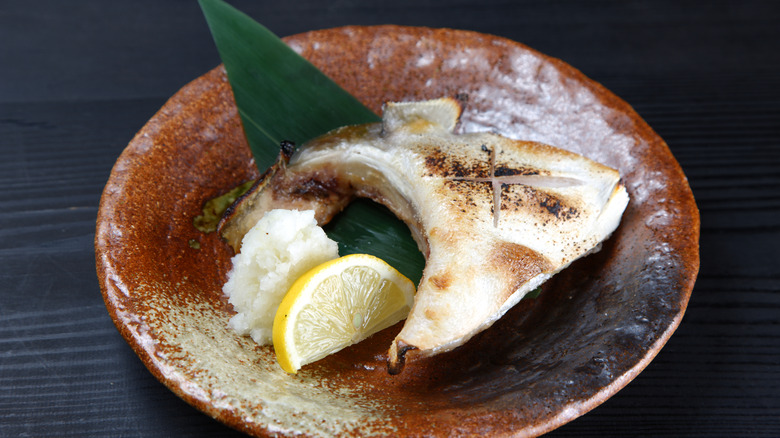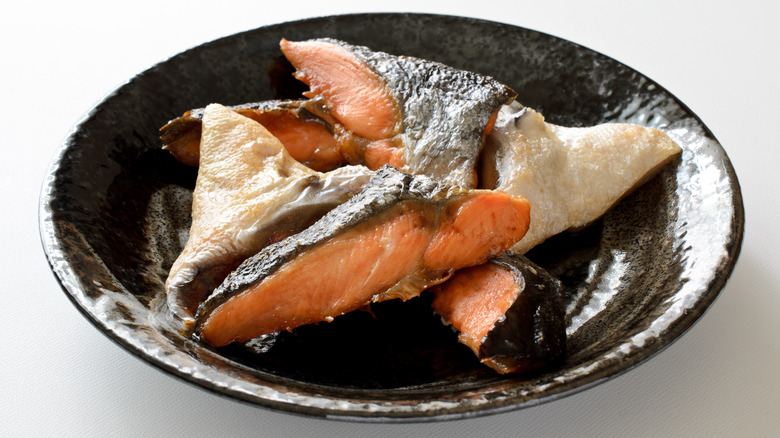What Are Fish Collars And How Are They Cooked?
Sometimes, the next best thing you've ever eaten has been under your nose the whole time. This is how it's been for fish collars. According to James Beard Foundation, popular fish filets (not unlike beef steaks) can make up as little as 25% of the fish, leaving the rest of the perfectly-edible, delicious, and nutritious animal unappreciated — or even wasted. One of the best ways you can address this is to consume as much of the fish as you can — and when it comes to the collar, you'll realize you've been missing out on some supremely good eats.
While you'll sometimes see fish collars (kama) translated on sushi restaurant menus as "jaw," the cut actually comes from behind the head, hence its name. This part of the fish is richly flavored with firm, succulent meat, a thick layering of delicious fat, and skin that holds it all together; Men's Journal compares collars to poultry dark meat. Garden & Gun reports, via Chef Josh Niland, that fish collars are appearing at upscale restaurants, while NOLA.com says they're often sold as "fin wings" and have long been popular in Asian cuisine. Here's how to find, prepare, and enjoy them yourself.
How to shop for fish collars
Fish collars can come from a variety of larger species, including yellowtail, tuna, salmon, striped bass, cod, cobia, swordfish, snapper, and grouper, to name a few. While you can order fish collars at many sushi restaurants, it's rewarding to add something new and exciting to your repertoire, especially if it teaches you how to respect what you eat. If you fish or you're fortunate enough to know someone who does, perhaps they'll share their collars with you. You can also seek a fishmonger or seafood counter — Men's Journal points out that collars may be inexpensive since they're sometimes considered offal. You can also find them online, or fresh or frozen at Asian markets.
To learn more about fish butchery hands-on, cut off the collars yourself from whole fish. James Beard Foundation says it's easiest to remove collars from fish weighing more than two pounds – underrated fish you should try that are littler are better cooked intact. Garden & Gun recommends using white fish for your first time, and explains, via Chef Josh Niland, that you can simply grasp the fish's pectoral fin located on either side of the head, bring it toward you, and free the collar by cutting behind the head and gill plate. The fin is kept on: it's like a chicken wingtip, Garden & Gun adds — making an attractive presentation and handle.
Cooking fish collars
Men's Journal explains that the rich flavor and fattiness of fish collars requires lengthy marinating; you'll often see soy sauce and citrus in recipes. NOLA.com says they're often prepared with a sweet and spicy sauce or a light batter. By far, the most popular methods for cooking fish collars call for high heat — creating crispy skin and moist morsels of fatty flesh. Chef Josh Niland pairs his panko-breaded, fried collars with DIY mayonnaise, herbs, and lemon. Just One Cookbook offers up a quick cooking recipe for hamachi kama that evokes the beloved Japanese sushi restaurant appetizer.
There's also Food Network's recipe for grilled fish collars, via Millie's Restaurant & Catering, which bakes the meat with a generous slathering of chimichurri. You can even season them like buffalo wings, or treat them like pork chops: see simple seared swordfish chops by Wulf's Fish, or Chef Niland's John Dory chops with anchovy and Carolina reaper butter. You'll know your fish is done when the tender meat slides easily out of the bone. Fish collars aren't the kind that get attached to a leash or tracked by GPS, but you'll definitely find yourself keeping them on your culinary radar. Give them a try and perhaps they'll be your gateway into further nose-to-tail eating adventures.


